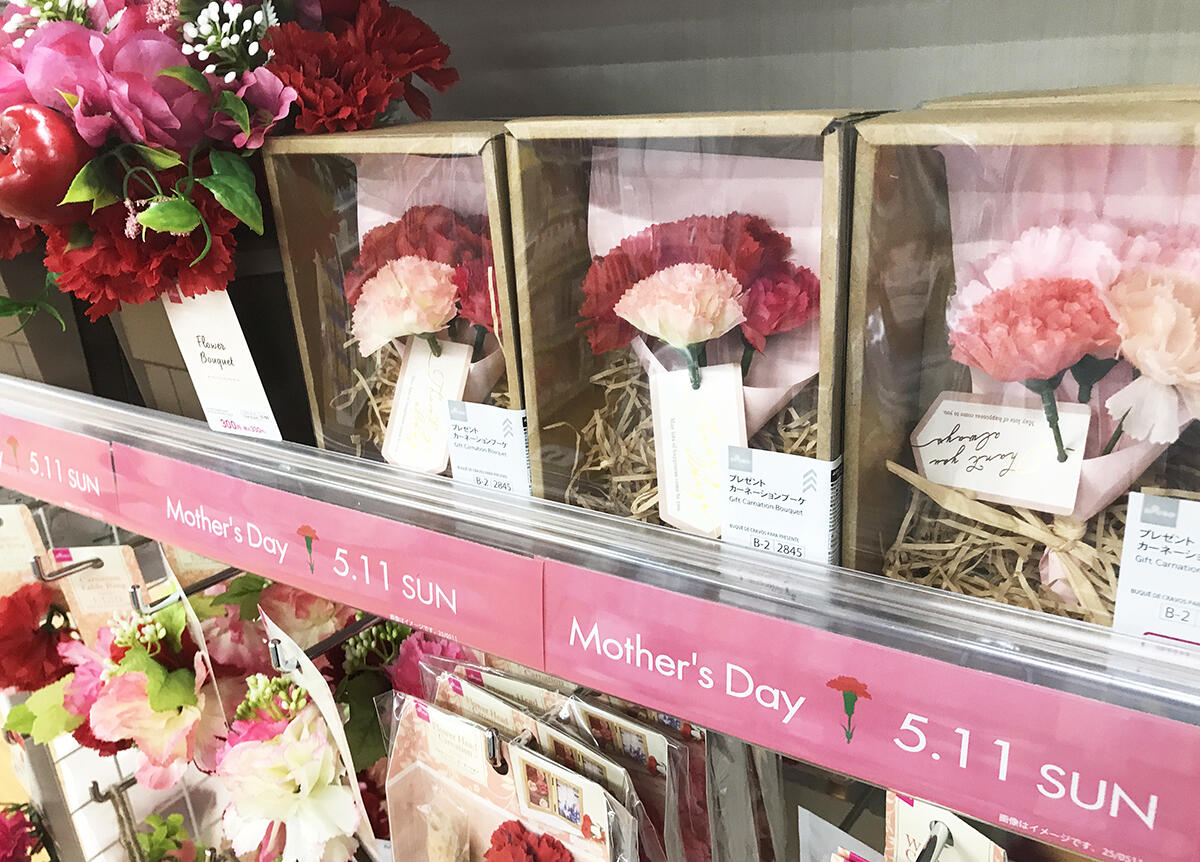お知らせ
- HOME
- ニュース&イベント一覧
- 【国際交流PRアソシエイトからの発信★】Japanese Mother's Da...
【国際交流PRアソシエイトからの発信★】Japanese Mother's Day (母の日)
留学生のリットさんが日本における母の日の由来や、贈られるカーネーションの色の意味について教えてくれました。
来年からは、プレゼントするカーネーションの色にも注意しながら母の日の贈り物を選びたいと思います。
Ritt, an international student, taught us about Japanese Mother's Day, such as the origin of Mother's Day, the meaning of the carnation color that is chosen as a present for mothers and more.
Next year, I would like to choose carnations for a Mother's Day gift while paying attention to their color.
---------
Japanese Mother's Day (母の日)
In Japan, May is not only known for the Golden Week holiday, but also for Mother's Day, which is celebrated on the second Sunday of May. In 2025, this special day falls on May 11th. Known in Japanese as 母の日 (Haha no Hi), Mother's Day is a time to show appreciation and love for mothers, just as in many other countries around the world.
Although the idea of Mother's Day originally came from the United States, Japan has embraced it and added its own cultural touches. The celebration began to spread in Japan during the Taisho era, influenced by Christian churches and women's organizations. Later, in 1936, a well-known confectionery company called Morinaga helped popularize the holiday by organizing events such as a nationwide song contest dedicated to mothers. These activities were widely covered by the media and helped make the day more familiar to people across the country.
The official celebration of Mother's Day in Japan began in 1949, inspired by a touching letter from Anna Jarvis, the founder of Mother's Day in the United States. The letter was sent to Aoyama Gakuin University in Tokyo and moved many people, including missionaries, who helped spread the message of honoring mothers.
One of the most beloved symbols of Mother's Day in Japan is the carnation. As the day approaches, flower shops are filled with red, pink, and purple carnations. These are sold in bouquets or potted arrangements. Each color has its own meaning--red stands for deep love, pink for gratitude and grace, and purple for pride. White carnations represent remembrance and are usually reserved for mothers who have passed away.
Besides flowers, it is common to give small gifts such as clothes, accessories, or handwritten letters to show love and appreciation. Sweets like cakes and cookies are also popular, and many shops offer special gift sets for the occasion. While there is no traditional food for Mother's Day in Japan, many families choose to take their mothers out to a nice restaurant or prepare a meal at home.
In Thailand, Mother's Day is celebrated on August 12th, the birthday of Her Majesty Queen Sirikit. It is traditional to give jasmine flowers, which symbolize purity and the deep, unconditional love between a mother and child.
Although different countries may celebrate Mother's Day on different dates and in different ways, the purpose remains the same: to express love and gratitude to mothers. As an international student at Iwate University, it is eye-opening to learn about these traditions and how they are shared around the world. Does your country have a similar or different way of celebrating Mother's Day? Let's share and learn together.
----
วันแม่
ที่ญี่ปุ่น เดือนพฤษภาคมไม่เพียงแต่มีวันหยุด Golden Week เท่านั้น แต่ยังมีวันแม่อีกด้วย ซึ่งตรงกับวันอาทิตย์ที่สองของเดือนพฤษภาคม ในปี 2025 วันพิเศษนี้ตรงกับวันที่ 11 พฤษภาคม วันแม่ซึ่งในภาษาญี่ปุ่นเรียกว่า 母の日 (Haha no Hi) เป็นช่วงเวลาแห่งการแสดงความซาบซึ้งและความรักต่อคุณแม่ เช่นเดียวกับอีกหลาย ๆ ประเทศทั่วโลก
แม้ว่าแนวคิดของวันแม่จะมาจากสหรัฐอเมริกา แต่ญี่ปุ่นก็รับเอาแนวคิดมาใช้และเพิ่มสัมผัสทางวัฒนธรรมของตนเองเข้าไป การเฉลิมฉลองวันแม่เริ่มแพร่หลายในญี่ปุ่นในยุคไทโช โดยได้รับอิทธิพลจากคริสตจักรและองค์กรสตรี ต่อมาในปี 1936 บริษัทขนมชื่อดังอย่าง Morinaga ได้ช่วยทำให้วันหยุดนี้เป็นที่นิยมมากขึ้นโดยจัดงานต่างๆ เช่น การประกวดร้องเพลงระดับประเทศที่จัดขึ้นเพื่อคุณแม่ กิจกรรมเหล่านี้ได้รับการนำเสนออย่างกว้างขวางโดยสื่อต่างๆ และช่วยทำให้วันนี้เป็นที่รู้จักมากขึ้นสำหรับผู้คนทั่วประเทศ การเฉลิมฉลองวันแม่อย่างเป็นทางการในญี่ปุ่นเริ่มต้นขึ้นในปี 1949 โดยได้รับแรงบันดาลใจจากจดหมายอันซาบซึ้งของแอนนา จาร์วิส ผู้ก่อตั้งวันแม่ในสหรัฐอเมริกา จดหมายดังกล่าวถูกส่งไปยังมหาวิทยาลัย Aoyama Gakuin ในโตเกียว และสร้างแรงบันดาลใจให้กับผู้คนมากมาย รวมถึงมิชชันนารี ซึ่งช่วยเผยแพร่ข้อความเกี่ยวกับการให้เกียรติคุณแม่
ดอกไม้ที่เป็น สัญลักษณ์อย่างหนึ่งของวันแม่ในญี่ปุ่นคือ ดอกคาร์เนชั่น เมื่อใกล้ถึงวันแม่นั้น ร้านขายดอกไม้จะเต็มไปด้วยดอกคาร์เนชั่นสีแดง ชมพู และม่วง ขายเป็นช่อหรือจัดในกระถาง โดยแต่ละสีมีความหมายในตัวเอง สีแดงหมายถึงความรักอันลึกซึ้ง สีชมพูหมายถึงความกตัญญูและความสง่างาม และสีม่วงหมายถึงความภาคภูมิใจ ดอกคาร์เนชั่นสีขาวหมายถึงการรำลึก และมักจะสงวนไว้สำหรับคุณแม่ที่ล่วงลับไปแล้ว นอกจากดอกไม้แล้ว การให้ของขวัญเล็กๆ น้อยๆ เช่น เสื้อผ้า เครื่องประดับ หรือจดหมายที่เขียนด้วยลายมือเพื่อแสดงความรักและความซาบซึ้งก็เป็นเรื่องปกติ ขนมหวาน เช่น เค้กและคุกกี้ ก็เป็นที่นิยมเช่นกัน และร้านค้าหลายแห่งก็มีชุดของขวัญพิเศษสำหรับโอกาสนี้ แม้ว่าในญี่ปุ่นจะไม่มีอาหารแบบดั้งเดิมสำหรับวันแม่ แต่หลายครอบครัวก็เลือกที่จะพาแม่ไปร้านอาหารดีๆ หรือทำอาหารที่บ้านรับประทานกัน
ในประเทศไทย วันแม่จะจัดขึ้นในวันที่ 12 สิงหาคม ซึ่งเป็นวันคล้ายวันพระราชสมภพของสมเด็จพระนางเจ้าสิริกิติ์ พระบรมราชินีนาถ ตามธรรมเนียมแล้ว จะมีการมอบดอกมะลิ ซึ่งเป็นสัญลักษณ์ของความบริสุทธิ์และความรักอันลึกซึ้งที่ไม่มีเงื่อนไขระหว่างแม่กับลูก
แม้ว่าประเทศต่าง ๆ จะเฉลิมฉลองวันแม่ในวันที่ต่างกันและในรูปแบบที่แตกต่างกัน แต่จุดประสงค์ก็ยังคงเหมือนเดิม นั่นคือการแสดงความรักและความกตัญญูต่อแม่ ในฐานะนักศึกษาต่างชาติที่มหาวิทยาลัยอิวาเตะ การเรียนรู้เกี่ยวกับประเพณีเหล่านี้และวิธีการถ่ายทอดไปทั่วโลกถือเป็นการเปิดหูเปิดตาให้ได้เรียนรู้ ประเทศของคุณมีวิธีการเฉลิมฉลองวันแม่ที่คล้ายคลึงหรือแตกต่างจากที่ญี่ปุ่นมั้ย มาร่วมแบ่งปันและเรียนรู้กันเถอะ











